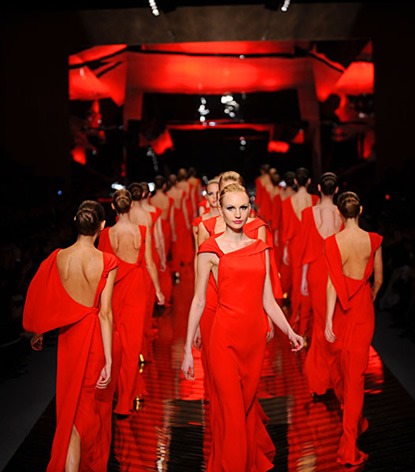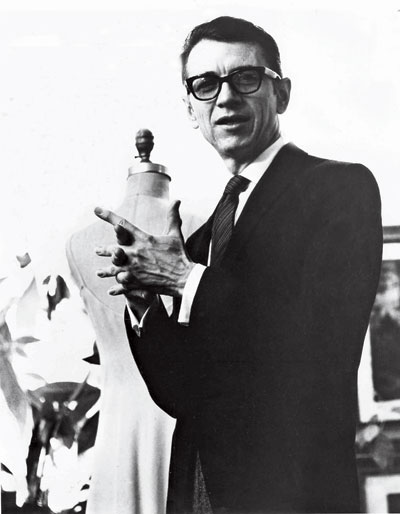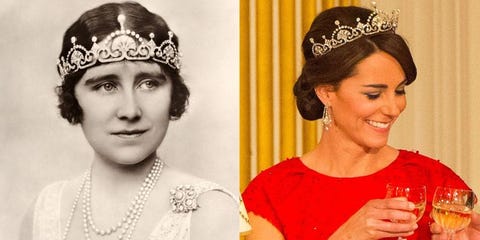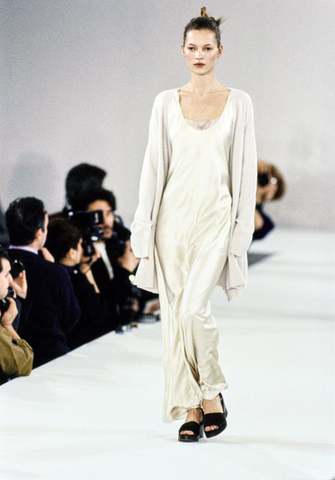talkingfashion » 1990s
-
History of Valentino
History of Valentino
By Paige McKirahan
There are few words that you think of when you hear Valentino, and most of them are associated with luxury. This haute couture label is one of the top fashion brands in the world and has been seen on industry magazines, runways, and red carpets around the globe. Everyone from the likes of Elizabeth Taylor to Naomi Campbell have been seen in these designs and with such a high profile presence in not only the fashion industry, but in the luxury industry as well, you would expect a history that lives up to fame. Valentino Garavani, the creator of the fashion house, made sure that in not only lived up to those expectations, but exceeded them.

(photo credits to wwd.com)
Garavani, an Italian native, was born in Voghera in 1932. He had an affinity for fashion starting at the beginning of his life, and eventually went on to study design in Paris at the beginning of 1950. He then was hired for his first design position with Jean Desses, and worked for them until 1967 when he obtained a position with Guy Laroche in his new atelier. After working there for two years and improving his taste and his technical skills, he returned to Italy and opened his own fashion house. At the end of 1957, he debuted his first haute couture collection and his refined lines and sophisticated aesthetic garnered great praise from publications like the Sunday Times in London.

Valentino with his collection for Guy Laroche in 1967
(photo credits to her.ie)
In the following three years, he quickly became the favorite of those in the “new Hollywood”, or Cincecitta, during great economic success in Italy. One of the first big names to wear a Valentino design was Elizabeth Taylor during her time filming Cleopatra in Rome. His collection for fall/ winter in 1961 boasted garments inspired by Jacqueline Kennedy, which only increased his growing global fame. His superstar status was secured after his 1962 show in Florence; the designs were so dazzling that he became the first Italian designer to have a French Vogue cover created in their honor.

Valentino 1961
(photo credits to pinterest.com)
His fall/ winter collection for 1963, which featured wild animal motifs, landed him in the pages of American Vogue, launching his popularity in the American market. The 1966 Valentino collection has become famous for its pop-art inspired pieces, which were aligned with the iconic movement during that decade. The 1960s proved to be quite prosperous for the brand as the designer’s pieces and accessories, especially his handbags sporting the luxurious gold “V”, were considered to be fundamental parts of a jet setting woman’s wardrobe. 1968 saw critical moments for the label; its spring/ summer line that year contributed to the dissipation of a haute couture crisis that involved people looking at less exclusive models. Following the show, shops opened up in Paris and Milan and later that year Valentino designed Jacqueline Kennedy’s wedding dress. These events made Garavani the most acclaimed designer in the industry at that and set the tone for the rest of his time with the brand.

(photo credits to pinterest.com)
The 1970s brought experimental changes; a boutique line was created alongside of the Valentino label itself, and both lines adopted an art deco aesthetic. The brand’s first namesake perfume was released in 1978, and it was followed by a line of blue jeans that made their debut at none other than Studio 54. Moving into the ‘80s, we see the rise of the famous Valentino red accompanied by classic black and whites; the silhouettes included a variety of draping, ruching, and dramatic details. The ‘90s saw a decade of celebrations for the brand’s 30 years in fashion through a series of films, books and exhibitions. Valentino himself sold the brand to Holding di Partecipazioni Industriali SpA (HdP) in 1998, but remained the creative director until his retirement in 2008; his last show was at the Musee Rodin in Paris and featured the most iconic set of supermodels from all of his decades in fashion. After Garavani’s retirement, Ferruccio Pozzoni and Alessandra Facchinetti took over his position and they were then succeeded by Maria Grazia Chiuri and Pierpaolo Piccioli shortly after, who still director the label today.

From Valentino's last show as creative director, 2008
(photo credits to loveofvalentino.blogspot.com)
Valentino has seen a wide collection of iconic accessories ranging from heels to bags. As I said before, the iconic “V” bag was a staple in womens closet and established the house as an essential brand. The Valentino Rockstud heel is quite possibly the most iconic piece to come out of the brand; these studded, strappy stilettos have been a favorite of street style aficionados and have inspired an entire line from the brand. This newfound studded fame reignited the brands popularity and has brought Valentino back to the forefront and into the closets of millions. Check out our favorite Valentino piece in our collection and gift yourself some classic red couture this holiday season!
-
The Master of Bias: Charles Kleibacker
The Master of Bias: Charles Kleibacker
By Paige McKirahan
Though there have been many iconic designers in the past century that have made a substantial mark on the fashion world, Charles Kleibacker may be the most enigmatic. Born in 1921 in Alabama, this American creator earned his nickname “Master of Bias” because of his affinity for complex gown designs involving cuts diagonal to the weave. Despite his iconic status in the fashion world, Kleibacker wasn’t always so well versed in the industry; he attended the University of Notre Dame and majored in journalism, which lead him to attend New York University for his graduate studies.

Kleibacker in 1565
(photo credits to threadmagazine.com)
He eventually relocated to California and met singer Hildegarde in San Francisco after running into one other in the same hotel. His large station wagon landed him a job as her driver and he toted around her and her entourage on tour all around the globe. It was in Europe when he finally realized his love for fashion after meeting a multitude of fashion designers through Hildegarde. His interest was piqued while in the offices of Christian Dior, and this prompted him to submit a set of early designs that earned him a spot at Lanvin in 1954. He worked there for three years and promptly returned to New York to work for Nettie Rosenstein, on the most highly regarded American fashion designers of her time.

Kleibacker for Lanvin, 1967
(photo credits to pinterest.com)
In 1959, he moved out of the shadow of others and into his own light when he began designing his own collection out of his brownstone in the Upper West Side. The line was a huge success and by the mid ‘60s, he was creating pieces for some of the most exclusive luxury clothiers including Henri Bendel and Bergdof Goodman. His trademarks were silk and wool crepe and of course, the bias cut; this special practice created designs that had a true cut look, not one that appeared stamped out.

Kleibacker designs
(photo credits to garmentozine.wordpress.com)
After his great success in New York, Kleibacker came to Ohio and became a Designer- in- Residence at The Ohio State University’s Costume and Textiles Collection. His work was a part of a 2005 exhibit there in the College of Human Ecology. He then became an adjunct curator of design at the Columbus Museum of Art and organized multiple fashion related exhibits. He remained there until the time of his death in 2010, when he passed away due pneumonia at 88 years old. Our very own CEO had the pleasure of working closely with him on multiple local fashion shows and events, making him also a close companion of our brand here at TalkingFashion. As an amazing designer so close to our home office, we felt it would only be appropriate to celebrate his wonderful life; one with a nickname like “Master of Bias” is hard to forget.
Sources:
Charles Kleibacker. (2018, October 06). Retrieved from https://en.wikipedia.org/wiki/Charles_Kleibacker
-
Headpiece Heaven: Five Fabulous Ornamental Accessories
Headpiece Heaven: Five Fabulous Ornamental Accessories
By Paige McKirahan
When it comes to the evaluation of headwear as an accessory rather than something worn out of necessity, it can truly make or break an outfit. Adding a scarf or hat to compliment a piece is customary, but what about more lavish head ornaments that are typically sported by royalty or those strutting the red carpet? Read on to learn about hair and head ornaments that emulate opulence from the top down!
This eclectic headwear is a more decorative alternative to the hat. Its roots can be traced back the Renaissance where it was customary for Christian women in Europe to sport head coverings. The use of the term came into circulation to describe the evolutionary form of this headpiece towards the end of the 20th century. Presently, it is typically worn at events where hats are customary and is accompanied by formal attire. They are commonly worn by woman as a covering during church services, weddings, or horse racing events. They are seen in great volume at royal events and Princess Beatrice of York wore a piece to Prince William and Catherine Middleton’s wedding that was so unusual, it became an internet sensation!
Tiara:
A tiara is a specific type of crown that tends to be bejeweled and ornamental in style. Appropriate for formal occasions of the white tie variety, this headpiece originates in Persia as a status symbol. The use of tiaras in ancient times declined with the rise of Christianity, but they saw a revival in the 18th century when Neoclassicism popularized the accessory for female adornment. Despite the fact that this revival was geared toward royalty, this piece has also been worn by wealthy commoners. The style is popular in the costume jewelry industry where they are worn by women for special occasions including homecomings, proms, quinceaneras, pageants, or weddings.

(image credits to harpersbazaar.com)
Hairpin:
The hairpin can come in many forms, but its basic function remains the same: to hold one’s hair in place. Whether the piece is elaborate and ornamental or utilitarian like a bobby pin, they are essential in creating different hairstyles. Coming from ancient Egypt and China, they were worn by all genders and were essential to hairstyling. They can also be used to note one's social or marital status. Now, they have a more decorative appearance and can be in the form of a barrette, bobby pin, or classic long straight pin.

(image credits to pinterest.com)
This hair accessory can be considered a variation of the hairpin; it is decorative and functional, with its main purpose being to hold a hat to the head. It was invented in Britain in the early 1800s and after its conception, the demand grew so great that a machine was created so it could be mass produced. In the late 1800s, bonnets became widely more circulated than hats, forcing hairpins into the closets of millions. They continued growing in popularity until the early 1900s until women began using them for self-defense purposes. They then began being regulated and their length decreased in order to deter wearers from using them as weapons.
Crown:
As the most traditional of headpieces on this list, the crown is a symbolic headwear typically won by royals. They represent power, victory, honor, glory, and legitimacy, and are often emblematic of the monarchy. These pieces can feature natural motifs, and they often are adorned with an assortment of expensive jewels. There are a variety of crown types and they can be used in coronations, at state occasions, or during weddings. You can even find their style being copied for novelty events (think Burger King's kid crowns!)

(image credit to us.hellomagazine.com)
Has Megan Markel and Harry's wedding got you feeling headpiece crazed? We can sate your desire for this royal glamour from the top down! Take a look at our collection to find headpieces for every occasion!
-
London Fashion Week SS'19 Accessories Trend Spotlight
London Fashion Week SS'19 Accessories Trend Spotlight
By Paige McKirahan
Welcome back to the Talkingfashion blog, fashion week lovers! Today, we have decided to take a look at the latest and greatest trends from London Fashion Week that spanned from September 14th to the 18th!



Many of the aesthetics and motifs from NYFW carried over across the pond, with ‘80s references and bright color schemes presented by a multitude of talented designers.
Animal inspired designs roared in Richard Quinn’s and Christopher Kane’s emphatic collections, both of which used prints and feathers to convey animalistic desires. There were fun themes put on display in lines that boasted mile high head pieces from Pam Hogg and a reimagining of fairytales by Ryan Lo!
Feminine aesthetics saturated collections with silk scarves and flowing details, perfectly accenting prim and proper designs seen in Riccardo Tisci’s first show for Burberry. Neon accessories and clothing were key in London (looking at you, ‘80s revival!) with single, dangling earrings in bright hues and large colorful hoops making statements in Fyodor Golan’s line.

Transparent pieces also channeled the ‘80s and ‘90s with Lucite lightning bolts and clear headpieces spicing up already flamboyant clothing designs. Androgynous styles originally popularized in the ‘70s are also a huge hit for this upcoming spring as Erdem Moralioglu’s Edwardian collection paid homage to male and female cross dressers throughout time.

Novelty bags and jewelry were the center of attention as vegetable inspired clutches were spotted accompanying models down the runway during Molly Goddard’s show. If you’re not into vegetable motifs, don’t worry; Peter Pilotto hopped on the novelty bag bandwagon as well with their ornate oversized and over-beaded bags.

In addition to food inspired designs, we also saw whimsical accessories inspired by bugs, flowers, and other household items in Matty Bovan’s collaboration with Coach.

If you’re tired of ‘80s aesthetic dominating, look to the revival of ‘60s tie dye this upcoming year as the colorful print is back and better than ever. Feeling like getting a head start on spring shopping or just looking for an excuse to buy some amazing new accessories? Check out our collections for pieces following all of SS ‘19’s trends!

(image credits to irishexaminer.com) -
The 1990s: The Battle of Street Style and Minimalism
The 1990s: The Battle of Street Style and Minimalism
By Paige McKirahan
Taking the crown as one of my favorite decades, the 1990s signified a transition from ‘80s garish to new age minimalism. Though it is difficult to assess the history of a fashion that seems as if it is still in style, there are some trends that aren’t as prominent as they once were (thankfully). In a time were technology was advancing at a higher pace than ever, it truly seems as if this decade is the beginning of modern society. Yes, we have seen an influence from Hollywood for decades, but pop culture affected fashion in an entirely new way during this period with the rise of boy bands, pop-stars, R&B, and the supermodel era.
Though ‘90s clothing still found inspiration in ‘80s silhouettes, it was the first to instigate a ‘60s revival. Loose and oversized styles remained while being complimented by mini-skirts, mini dresses, and tighter styles. Space age aesthetics reigned as white tones, metallic, and references to cosmology were widely popularized. Similar to the ‘60s, this decade saw a division of styles come into circulation and the two main groups can be roughly separated into street style and elegant minimalism. The ladder included a colorless palette with silky, leathery, and velvety fabrics. Silhouettes were linear and simple boasting a relatively neutral color palette. Looking “rich” became cool again and the popularity of name brand designers was restored. They followed the shape of the ideal body which was, at the time, slim and toned. Need help visualizing this aesthetic? Reflect back to ‘90s Calvin Klein or Armani.

Kate Moss in ‘90s Calvin Klein
(photo credit to pinterest.com)
Street style was absolutely the opposite. Garnering influence from sports and hip hop, this was a trend that had attitude and a sense of boldness never seen before. MTV could be seen on every television and artist’s laid back styles gave copious amounts of inspiration for streetwear lovers. It was oversized, sporty, and relaxed, boasting large t-shirts with bold prints as the center of attention. Women also loved crop tops and loose fitting, high waisted jeans. Bomber jackets and boots, especially Timberlands, could be seen on rappers and young women alike. This style loved denim, and also used hints of leather and fleece to make oversized sweaters more comfortable than ever. The ‘90s were the first decade where sneakers came into their own, shooting themselves to high fashion status; Vans, Converse, Nikes (especially ones endorsed by athletes), Reeboks, Jordans, and New Balances could be seen on even those most well versed in fashion.

Tyra Banks ‘90s street style
(image credits to pinterest.com)
Preppy and grunge aesthetics reigned along with street style as movie stars and musicians were the driving force behind stylistic choices. Loved by affluent teenagers, preppy style was inspired by Clueless and Ivy League trends. Blazers, polos, all things Ralph Lauren, and plaid was worn everywhere; mini-skirts, crop tops, and everything in between could be seen covered in bright colors or with preppy motifs. Leisure style for this trend included denim overalls, which are loved by all style communities in this decade.
Grunge, on the other hand, finds in inspiration for its vision in bands like Nirvana and actress Drew Barrymore. Those that were interested in this style have similar taste to punk lovers of the ‘70s, but in a more subdued manner. These wardrobes included an assortment of jackets, sweaters, skirts, and footwear with a worn in look that made it hard for couture designers to have successful collections in this aesthetic.

Kurt Cobain in grunge style
(image credit to retrowaste.com)
Jewelry trends in the 90s moved away from the flashiness of the ‘80s and had a more minimal aesthetic. Swatch watches, slap bracelets, anklets, toe rings, and puka shell necklaces all were beloved accessories in this decade. Chokers were a youthful favorite that have been revived in the late 2010s, and scrunchies have made a comeback as bracelets at the beginning of this year! Tiny sunglasses in an endless supply of bright colors also moved away from the huge specs loved by the ‘80s and ‘70s.
Lucite was a popular material and was commonly used to make chunky rings in bright colors, among other jewelry styles. Celestial motifs, smiley faces, peace signs, and ying-yang icons adorned pieces and gave use a sense of ‘60s nostalgia. Name plate necklaces a la Carrie Bradshaw are just as trendy now as they were then along with hoop earrings of all sizes. This decade also loved the use of crystals and gems in their jewelry, especially if they were color changing depending on your mood.
A mere 20 years ago when all of these trends burst onto the scene, no one could have anticipated their overwhelming popularity in the 2010’s. If you’re loving this ‘90s revival as much as I am, head on over to our collections so you can own some hoops and chokers of your own!





















